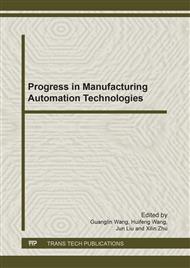[14]
The changeness of the corrosion potential proves the deposits a more obvious protective function containing more active composition with a better corrosion resistance. Table 2 The corrosion potential and exchange current density of the deposits as-deposited NiMo18. 17 NiMo21. 34 NiMo26. 78 NiMo33. 46 φs / V -0. 321 -0. 223 -0. 280 -0. 298 i0×10-6 / A·cm-2 4. 16 6. 64 7. 58 41. 62 The hydrogen evolution perfomance of the deposits. Figure 5 shows the hydrogen evolution performance of the deposits in 25℃{TTP}8451 , 7mol·L-1 KOH alkaline solution. It describe that the starting potential of the deposits rises firstly and falls later with the Mo atom content increase, suggesting the addition of Mo element promotes the electrodes activity and decreasing the hydrogen evolution overpotential. There is a coupling relationship between the Ni2+ (Mo4+) and OH-, the combination of the Ni2+, MoO43- and Cit3+ is easy to gather on the surface of the negative pole in alkaline solution. Because of the minus of the potential of the Mo element, the possibility that it maybe deoxidationed itself is little, the sever polarization of the negative pole and the obvious enhance of the hydrogen evolution phenomenon caused the structure of the deposits which is loosen and multi-bubble. The structure is textured the regular size of 20th polyhedron with a large surface area. The low hydrogen evolution overpotential is related to the inside structure of the deposits because of the increase of the contacted surface improved the electrolysis efficiency in the electrolysis process [15-20]. It might be found that the more active structure in the deposits compounded of Mo and Ni from fig. 3 would improve the chemical properties in alkaline solution for the hydrogen evolution. This structure would absorbe the short radius atom H and dissolves it in electrolysis, which can provide more activity during the process, accordingly promote the activity of the alloy electron. The activity of short-distance atoms cluster providing a large amount of activity inside the alloys plays an important role in the electrolysis process. Fig. 5 Hydrogen evolution performance of the deposits (a)18. 17 (b)21. 34 (c)26. 78 (d)33. 46 (Mo at. %) Conclusions 1) The foamed Ni-Mo deposit was obtained by the pulsed electrodeposition technique. The multi-bubble pore were obviously stratifies with a structure of pentagonal or hexagonal skeleton. The deposits surface is relatively rough and has a large surface area. 2) The Ni-Mo deposits has a higher porosity, the structure of the aperture gradually becomes inattentive and crevice along with the Mo atom increasing. This would cause a powerful inner-strain and weak strength of the combination. 3) The Ni-Mo deposits acquired in the alkaline solution present the characteristics of amorphous and possess a higher chemical activity. 4) The foamed Ni-Mo deposits behave a low hydrogen evolution overpotential and a better corrosion resistance in 25℃{TTP}8451 , 7mol·L-1 KOH alkaline solution. The overpotential of the deposits rises firstly and falls later as of the Mo atom increase, which is highly attached to the deposits surface structure. The activity of short-distance atoms clusters inside the deposits also decrease the hydrogen evolution overpotential and improve the activity of the catalysis. Reffrences.
Google Scholar
[1]
Divisek J. High efficient advanced alkaline electrolyzer for solar operation, electrochemical hydrogen technologies. New York, 1990. 162.
Google Scholar
[2]
Li N., Gao CH., Materials Protection. 2008, 41: 47-52.
Google Scholar
[3]
Paseka I. Electrochimica Acta, 2001, 47: 921-931.
Google Scholar
[4]
Hao Lei, Zhen Song, Dali Tan, et al. Applied Catalysis A: General, 2001, 214: 69–76.
Google Scholar
[5]
Kiros Y., Majari M., Nissinen T.A. J. Alloys and Compounds, 2003, 360: 279–285.
Google Scholar
[6]
Al-Saleh M.A., Sleem-Ur-Rahman, Kareemuddin S.M.M.J., Al-Zakri A.S. J. Power Sources, 1998, 72: 159-164.
DOI: 10.1016/s0378-7753(97)02704-3
Google Scholar
[7]
Han Q, Chen J.S., Liu K.R., etal. Int. J. Hydrogen Energy, 2004, 29: 243-248.
Google Scholar
[8]
Koteski V., Mahnke H. -E., Belošević-Čavor J., Cekić B., Schumacher G., Acta Materialia, 2008, 56, 4601-4607.
DOI: 10.1016/j.actamat.2008.05.015
Google Scholar
[9]
Zhuang Y, Podlaha E.J. J. Electrochemical Society, 2000, 147: 2231-2236.
Google Scholar
[10]
Li N., Gao C.H., Yang S.Z. Transactions of Materials and Heat Treatment. 2008, 29: 144-148.
Google Scholar
[11]
Gennero de Chialvo M.R., Chialvo A.C. J. Electroanalytical Chemistry, 1998, 448: 87-93.
DOI: 10.1016/s0022-0728(98)00011-4
Google Scholar
[12]
Adrian Canzian, Hugo Mosca, Guillermo Bozzolo., Applied Surface Science, 2007, 254: 392- 396.
Google Scholar
[13]
Li N., Gao CH. Journal of the Chinese Rare Earth Society, 2010, 28: 241-246(in chinese).
Google Scholar
[14]
Zha Quanxing. Introduction to the electrode kinetics, Beijing, Science Press Publication(Third Edition). 2002, 236-257.
Google Scholar
[15]
Jiao J, Bu SY, Wang GC, et al., J. Molecular Structure: Theochem, 2008, 862: 80-84.
Google Scholar
[16]
Mikolaj Donten, Henrikas Cesiulis, Zbigniew Stojek., Electrochimica Acta, 2005, 50: 1405-1412.
DOI: 10.1016/j.electacta.2004.08.028
Google Scholar
[17]
Okido M, Depo J K, Capuano G A. J Electrochem Soc, 1993, 140: 127-133.
Google Scholar
[18]
Wang Y, Woodward C, Zhou S H, etal. Scripta Materialia, 2005, 52: 17-20.
Google Scholar
[19]
Jaksic J M, Vojnovic M V, Krstajic N V. Electrochimica Acta, 2000, 45: 4151-4158.
Google Scholar
[20]
Zhou S H, Wang Y, Jiang C, etal. Materials Science and Engineering A, 2005, 397: 288-296.
Google Scholar


